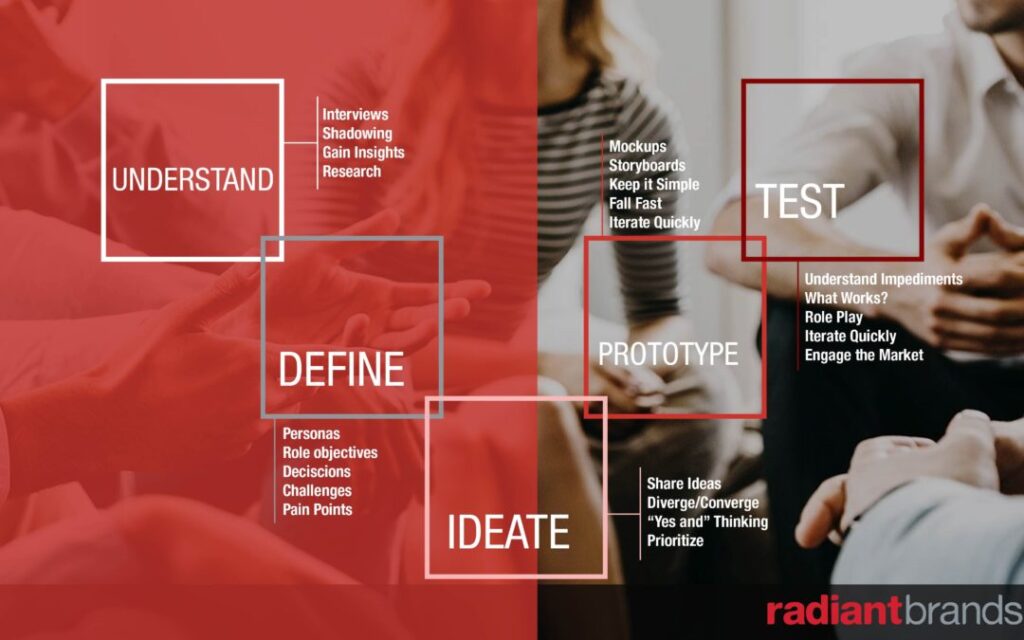
Design Thinking. Shaping Strategies with People in Mind.
Design Thinking is Understanding People.
Design thinking is used in a wide range of areas, from software development to engineering solutions, creative marketing approaches, and business strategies. Why? Because it uses both creative and critical thinking to tackle problems that are long-established, ill-defined, or unknown, and re-frames the issue. In this process, the design outcome becomes both functional and aesthetic because it has a purpose and you can measure effectiveness.
At its core, design thinking centers on a deep interest in understanding those you’re designing for; your users, customers, and groups. It’s an interactive process that allows you to engage with your audience and not repeat the same patterns of thinking and design approaches but to create something new, innovative, and connecting. This approach allows you to bring in customers’ perspectives that you may not have considered before. It allows you to target a customer segment you did not realize was even there, and then come up with creative solutions.
Stuck Under an Overpass and a New Way to Solve a Problem.
When a delivery truck got jammed under a train bridge, experts from the traffic and fire department arrived to figure out what to do. Gathered around the truck, many started thinking about how they could pull the vehicle out. Some suggested dismantling part of the bridge which would take days. At this point, traffic started to pile up, and a little boy walked by to observe the scene. In the middle of the chaos, the boy pointed his finger at the tires of the truck. “Why not let the air out of the tires?” he suggested. All the experts looked totally shocked. But this option seemed less expensive than dismantling the bridge, so they tried it. After releasing the air out of the tires, the truck was lowered by three inches and backed out of the bridge with minimal damage. It was this little boy’s suggestion that got the truck out in the end. Discovering a new way of looking at issues changes everything.

Challenging the Ways We Frequently Approach Issues.
Design thinking challenges our habits and perceptions. It also challenges the way we approach problem-solving or design. It’s about coming up with creative solutions by understanding your users, defining their needs, and their personas, challenging assumptions and then ideating or creating new ways of approaching a problem. In other words, pushing past obvious solutions to get to those breakthrough ideas.
Humans naturally develop patterns of repetitive activities.
This is why we know how to tie our shoes, drive cars, and make toast. These assist us in quickly applying the same actions and knowledge in similar or familiar situations, but they also have the potential to prevent us from quickly and easily accessing or developing new ways of seeing, understanding, and solving problems.
Putting aside our natural human patterns and thinking outside the box can help us solve problems and discover solutions we didn’t see before. Design thinking is all about thinking outside the box.

Market-Driven Data and Testing Provide Real Insights.
When you bring in research and look at people in their world, you can redefine approaches to how you build products or develop marketing strategies. You can find motivating factors that shape their behavior and create what will bring customers to your products and give your users a better experience using your website or product. The key is really experimenting and testing ideas, framing marketing solutions for customers along with measurable approaches that take into account customers and markets.
Thinking Through Each Persona User Can Have a Huge Impact.
For example, when designing websites for seniors, the fonts, size of type, and colors become critical aspects of what makes for a functional and usable site. Understanding the demographic and behavior of customers can really shape the effectiveness of your design approach.
Reaching the Right People with Their Perspective in Mind.
Using design thinking provides a way of finding better solutions to competitive marketing environments by seeing what customers really want. It’s more transparent and engaging. Radiant looks at design thinking as a way of shaping a brand, a website, and an urban development project from a unique customer-centric perspective that brings out unique creative solutions.